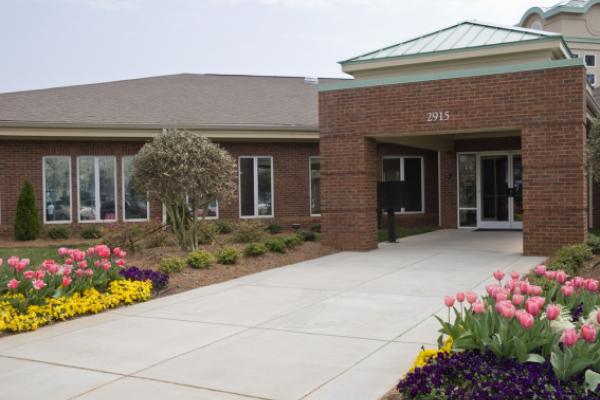3 high-dividend healthcare REITs with positive returns over the past year
Malls and strip malls have been in decline for many years. How many empty spaces did you see in your local mall on your last visit? Have you seen any new malls or malls being built recently? Main streets across America have also had vacant storefronts for a long time. Due to pandemic shutdowns and the ease of shopping online, the death of brick-and-mortar retail has accelerated.
Also, due to recent COVID restrictions, people have become accustomed to working remotely. It's a wonderful thing to do your work from your home office, your kitchen table, next to a swimming pool or on a terrace overlooking the ocean. Companies that don't offer remote or hybrid job opportunities struggle to fill positions and retain good employees. With all of this in mind, a growing number of forward-thinking investors are questioning the wisdom of investing their money in commercial real estate, such as retail or office buildings, either directly or in real estate investment trusts (REITs).
Alternatives to brick-and-mortar retail and office buildingsThere are alternatives to investing in commercial and office buildings. Newly built multi-family apartment complexes are opening across the country. The cost of single-family homes has risen so dramatically in recent years — especially in some markets — that middle-class people can only afford to rent. The need for rental properties seems to be growing more and more.
There are also opportunities for investors to take advantage of growing healthcare needs, particularly as the baby boomer generation ages. New hospitals, medical clinics and assisted living facilities are sprouting up everywhere. It is estimated that by 2050, 15 million older people will need long-term care.
But it's needed now. On average, patients who enter long-term care facilities for rehabilitation will be residents for 270 days until they recover and leave to return home. Those who enter long-term care facilities at the end of their life typically stay there for an average of 835 days before dying. There is a huge need for such facilities.
Current challenges with healthcare propertiesUnfortunately, few people can afford long stays in nursing homes or memory care facilities, so they end up relying on Medicare and Medicaid. But these government programs have reduced their reimbursement levels in recent years. Healthcare workers have also left the field due to low wages. Several states have recognized the problem of low wages and have imposed higher wages. In response to these difficulties, if they have the means, many seniors stay in their residence or in assisted living facilities longer than before before going to an EHPAD. Personal home care, seniors' meal centers and adult day care centers have helped fill the void.
Healthcare REITs that can benefit investorsThe need for health care facilities will only increase as our population ages and more seniors require assistance with their health and of life. This provides an opportunity for REIT investors who want a stake in healthcare properties, but don't want the headaches that often come with limited partnerships or other forms of real estate investing that require large outlays. cash.
The National Association of Real Estate Investment Trusts (Nareit) website shares information on 15 healthcare REITs. Of these 15, only three show positive total returns for the past year, although there are four that show positive returns over a longer period. The 3 REITs showing positive returns over the past 12 months are LTC Properties, Inc., Omega Healthcare Investors, Inc. and National Health Investors, Inc.
The 4 REITs that show positive returns over longer periods that should be discussed in more detail in another article are Community Healthcare Trust, Inc. CHCT, Healthpeak Properties, Inc. PEAK, Medical Properties Trust, Inc....

Malls and strip malls have been in decline for many years. How many empty spaces did you see in your local mall on your last visit? Have you seen any new malls or malls being built recently? Main streets across America have also had vacant storefronts for a long time. Due to pandemic shutdowns and the ease of shopping online, the death of brick-and-mortar retail has accelerated.
Also, due to recent COVID restrictions, people have become accustomed to working remotely. It's a wonderful thing to do your work from your home office, your kitchen table, next to a swimming pool or on a terrace overlooking the ocean. Companies that don't offer remote or hybrid job opportunities struggle to fill positions and retain good employees. With all of this in mind, a growing number of forward-thinking investors are questioning the wisdom of investing their money in commercial real estate, such as retail or office buildings, either directly or in real estate investment trusts (REITs).
Alternatives to brick-and-mortar retail and office buildingsThere are alternatives to investing in commercial and office buildings. Newly built multi-family apartment complexes are opening across the country. The cost of single-family homes has risen so dramatically in recent years — especially in some markets — that middle-class people can only afford to rent. The need for rental properties seems to be growing more and more.
There are also opportunities for investors to take advantage of growing healthcare needs, particularly as the baby boomer generation ages. New hospitals, medical clinics and assisted living facilities are sprouting up everywhere. It is estimated that by 2050, 15 million older people will need long-term care.
But it's needed now. On average, patients who enter long-term care facilities for rehabilitation will be residents for 270 days until they recover and leave to return home. Those who enter long-term care facilities at the end of their life typically stay there for an average of 835 days before dying. There is a huge need for such facilities.
Current challenges with healthcare propertiesUnfortunately, few people can afford long stays in nursing homes or memory care facilities, so they end up relying on Medicare and Medicaid. But these government programs have reduced their reimbursement levels in recent years. Healthcare workers have also left the field due to low wages. Several states have recognized the problem of low wages and have imposed higher wages. In response to these difficulties, if they have the means, many seniors stay in their residence or in assisted living facilities longer than before before going to an EHPAD. Personal home care, seniors' meal centers and adult day care centers have helped fill the void.
Healthcare REITs that can benefit investorsThe need for health care facilities will only increase as our population ages and more seniors require assistance with their health and of life. This provides an opportunity for REIT investors who want a stake in healthcare properties, but don't want the headaches that often come with limited partnerships or other forms of real estate investing that require large outlays. cash.
The National Association of Real Estate Investment Trusts (Nareit) website shares information on 15 healthcare REITs. Of these 15, only three show positive total returns for the past year, although there are four that show positive returns over a longer period. The 3 REITs showing positive returns over the past 12 months are LTC Properties, Inc., Omega Healthcare Investors, Inc. and National Health Investors, Inc.
The 4 REITs that show positive returns over longer periods that should be discussed in more detail in another article are Community Healthcare Trust, Inc. CHCT, Healthpeak Properties, Inc. PEAK, Medical Properties Trust, Inc....
What's Your Reaction?















![Three of ID's top PR executives quit ad firm Powerhouse [EXCLUSIVE]](https://variety.com/wp-content/uploads/2023/02/ID-PR-Logo.jpg?#)







